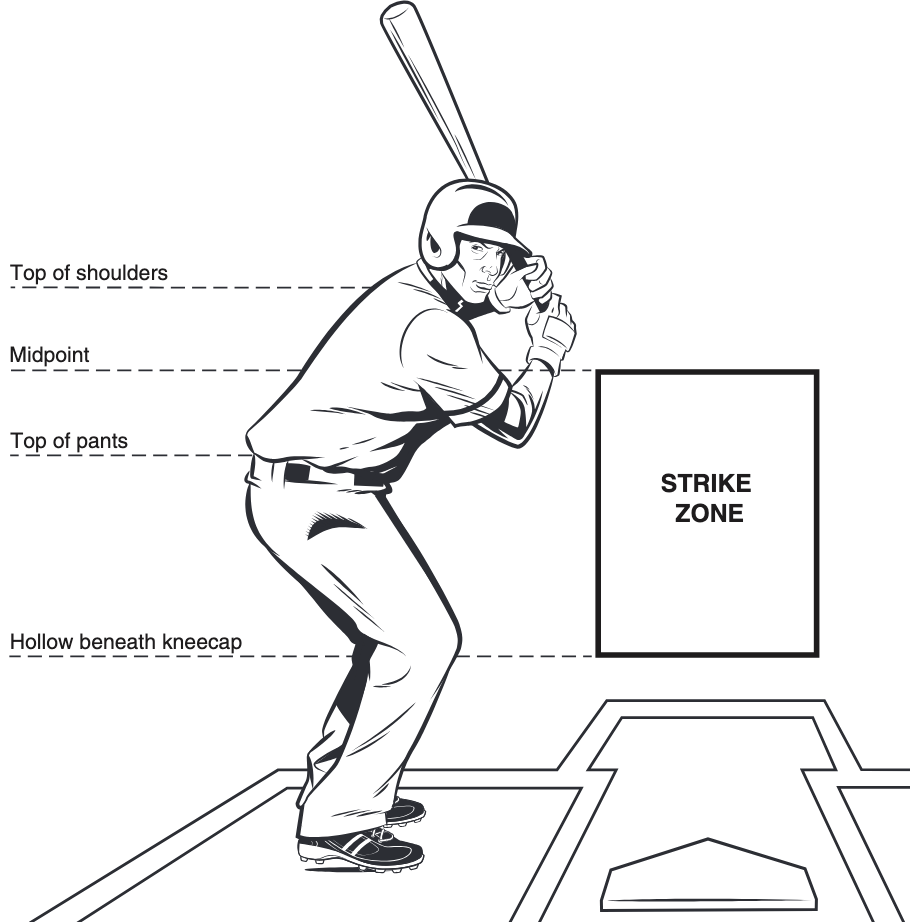
Image courtesy of the official MLB rulebook.
The Strike Zone, Explained
When the ball is pitched, the target for that pitch is, usually, something called the “strike zone.” The strike zone is the area in which a hitter could be reasonably expected to swing at and, yes, strike (or hit) a pitch. This, really, is the essence of baseball: the pitcher throws the ball, the batter tries to hit it. The strike zone is where this battle comes to a head. If a batter does not swing at a pitch (also called "taking" a pitch), and that pitch passes through any point of the strike zone, is by rule a strike. A pitch that misses the strike zone, on the other hand, is a ball, at least by rule. If the batter accumulates three strikes over the course of a plate appearance, they are out, and if they accumulate four balls, they are walked, and get to take first base.
But, what is the strike zone? Fair question. To be a strike, some part of the ball must pass over home plate. Thus, the horizontal span of the strike zone is always 17 inches across, the width of home plate. Likewise, the strike zone’s depth matches home plate’s ranging from 8.5 inches to 17 inches. The vertical dimensions, meanwhile, vary depending on whomever is up to bat. This dimension is found when the batter is “crouched at the plate and prepared to swing.” The top point is “the midpoint between a batter’s shoulders and the top of the uniform pants,” while the bottom point is “just below the kneecap.” As such, a taller batter will have a taller strike zone, and a shorter batter will have a shorter strike zone.
Now, you might have noticed the words "by rule" in the preceeding paragraphs, especially regarding the outcomes of pitches. Distinguishing strikes from balls is the job of the home plate umpire, which brings us to a point universally acknowledged: calling balls and strikes is a tough job, and even the best and most diligent of umpires will occasionally get pitches wrong1. This can be the cause of a lot of consternation and drama! Neither players nor coaches are allowed to argue with the umpire about ball/strike calls. Many will still grumble, of course, and if things get too out of hand, the umpire can eject the offending player or coach from the game. Often, this takes the form of a manager racing out and getting in an umpire’s face in order to save their player from getting ejected. A good umpire will generally allow for someone to vent their frustrations without escalating the situation; a bad umpire will vent their own frustrations and make the situation worse for just about everyone involved. Sometimes this can be good theater. Sometimes it’s just embarrassing.
In the end, for an umpire, the most important part of calling balls and strikes is not necessarily getting those calls right (though of course, every umpire will want to do so), but making their calls be consistent. If a pitch is called one way, a subsequent pitch that lands in the same location should be called the same way.
All of this is to say that if you are watching a game from home, on the television, you will inevitably see a rectangle on the screen, purporting to represent the strike zone. It’s important to remember that there is nothing official about this projection2; it’s just a projection, and its accuracy can be highly affected by the position of the camera that’s filming the action. It also tends not to change vertically between batters, even when those batters are of different heights. And to top it off, the projection is also a two-dimensional representation of a three-dimensional space, which is obviously going to introduce a margin for error on the whole affair.
The final note here is that while many of the calls that umpires make can be subject to some form of replay review, ball and strike calls are not. MLB has pitch-tracking technology that it uses to rate umpire performance (and you will occasionally see the fruits of this during broadcasts when you can see the official pitch track used as a replay), but this technology isn’t yet considered good enough to use officially. MLB has used its minor leagues as test labs for various types3 of automated ball/strike calling, and it feels inevitable that such a system will eventually make its way to the major leagues, but there is currently no clear timetable for that to happen.